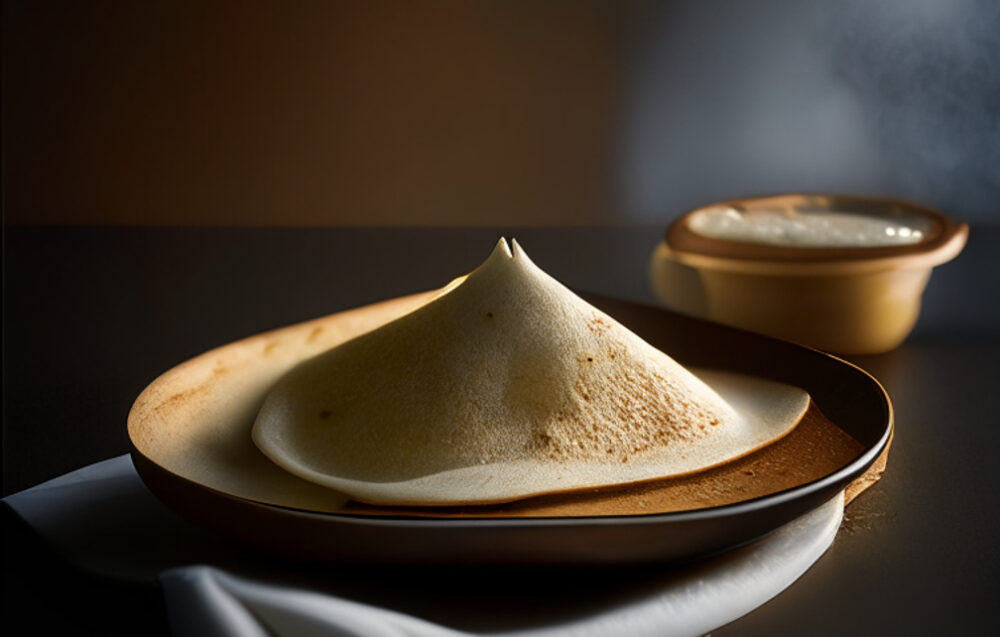Neer Dosa is a traditional South Indian delicacy that has gained popularity for its unique texture and subtle flavours. “Neer” translates to “water” in the Kannada language, perfectly describing the thin and delicate nature of this crepe. Made from a simple rice batter, Neer Dosa is a versatile dish that can be enjoyed with a variety of accompaniments. In this blog post, we delve into the world of Neer Dosa, exploring its distinct characteristics, the preparation process, and tips to savour this refreshing and light South Indian delight.
Light and Refreshing Flavors
Neer Dosa is known for its light, almost translucent texture and subtle flavours. The crepe is made from a batter consisting of soaked rice and water, resulting in a crepe that is thin, soft, and slightly chewy. The mild taste of Neer Dosa allows it to pair perfectly with both savoury and sweet accompaniments, making it a versatile dish suitable for any time of the day.
Preparation Process
Creating Neer Dosa involves a straightforward process that requires minimal ingredients. Here’s a step-by-step guide:
Step 1: Soak rice: Start by soaking raw rice (preferably sona masuri or any short-grain rice) in water for around 3-4 hours or overnight. This ensures the rice becomes soft and easily grindable.
Step 2: Grind the batter: Drain the soaked rice and transfer it to a blender. Add water gradually and blend until you achieve a smooth and flowing batter consistency. The batter should be thin, similar to the consistency of milk.
Step 3: Season the batter: Add a pinch of salt to the batter and give it a gentle mix. You can also add a few drops of oil to prevent the dosas from sticking to the pan.
Step 4: Cook the Neer Dosa: Heat a non-stick or cast-iron skillet on medium-high heat. Pour a ladleful of the batter onto the hot pan and spread it in a circular motion to create a thin crepe. Cover the dosa with a lid and cook for a minute or until the edges start to lift. There is no need to flip the dosa.
Step 5: Serve and Repeat: Once the dosa is cooked, gently fold it and transfer it to a plate. Serve Neer Dosa immediately with your choice of accompaniments.
Tips for Enjoying Neer Dosa:
- Accompaniments: Neer Dosa pairs well with a wide range of accompaniments. For a savoury twist, serve it with coconut chutney, sambar (lentil soup), or any South Indian curry. If you prefer a sweeter option, Neer Dosa tastes delicious with a drizzle of honey or a side of coconut jaggery mixture.
- Experiment with Fillings: While cooking the dosa, you can sprinkle some chopped onions, finely chopped green chillies, or freshly grated coconut onto the surface. This adds an extra layer of flavour and texture to the dosa.
- Storage and Reheating: Neer Dosa is best enjoyed fresh and warm. However, if you have leftovers, store them in an airtight container in the refrigerator. To reheat, lightly steam or warm the dosas in a pan before serving.
- Mastering the Consistency: Achieving the right batter consistency is crucial for perfect Neer Dosa. The batter should be thin, but not watery. If the dosas turn out thick, add a little water to thin down the batter. If they tear easily, reduce the water content slightly.
Conclusion
Neer Dosa is a delightful South Indian crepe that offers a light and refreshing culinary experience. With its delicate texture and versatility, Neer Dosa has become a favourite among food enthusiasts. Whether enjoyed with savoury or sweet accompaniments, this simple yet flavorful dish is sure to please your taste buds. Embrace the art of making Neer Dosa and savour the gentle flavours of this beloved South Indian delicacy.





